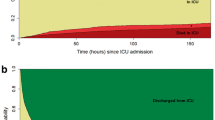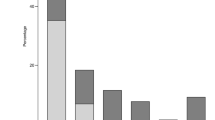Background Secondary pathophysiological CPP insult is related to outcome after head injury, and improved management would be expected to reduce secondary brain insult. Paediatric head injury management guidelines have been published in recent years, by SIGN (2000), RCPCH (2001), NICE (June 2003), and jointly by Critical/Intensive Care Societies (C/ICS July 2003). We investigated whether outcome of children's head injury (and total burden of secondary CPP insult) has changed (1) annually; (2) before and after the introduction of any HI guidelines, and (3) following other service changes.
Methods Seventy-six children (aged 1–14 years with severe HI) were admitted to the Edinburgh Regional Head Injury Service between 1989 and 2006, and dichotomised at various time points and compared in terms of: demographic factors, intracranial pressure (ICP), cerebral perfusion pressure (CPP) insults [e.g. age-banded pressure—time index (PTI)], and Glasgow Outcome Scale (GOS) score (assessed at 6 months post injury).
Findings When dichotomised around the SIGN guidelines, there were no statistically significant differences between the two group's demography or in primary brain injury, but the outcomes were different (p=0.03), with 6 vs 4 GOS1 (died), 2 vs 4 GOS3 (severely disabled), 5 vs 16 GOS4 (moderately disabled) and 23 vs 14 GOS5 (good recovery), when comparing before and after year 2000. GOS4 was significantly different (chi-square=7.99, p<0.007). There was a (non-significant) trend for the later years to have longer insult durations of ICP, hypertension, CPP, hypoxia, pyrexia, tachycardia and bradycardia, greater PTI for both CPP and ICP, and more CPP insults (p=0.003). There was, however, significantly less CPP insult (p=0.030) after the introduction of the more management-oriented C/ICS guidelines.
Conclusions The most recent paediatric HI guidelines appear to have reduced the burden of secondary insult, but more time is required to determine if this will be reflected in improved outcomes.
Access this chapter
Tax calculation will be finalised at checkout
Purchases are for personal use only
Preview
Unable to display preview. Download preview PDF.
Similar content being viewed by others
References
Adelson PD, Bratton SL, Carney NA, Chesnut RM, Du Coudray HEM, Goldstein B, Kochanek PM, Miller HC, Partington MD, Selden NR, Warden CR, Wright DW (2003) Guidelines for the acute medical management of severe traumatic brain injury in infants children and adolescents. J Trauma Inj Infect Crit Care 54 (Suppl 6):S237–S239
Chambers IR, Kirkham FJ (2003) What is the optimal cerebral perfusion pressure in children suffering from traumatic coma? Neurosurg Focus 15(6):E3
Chambers IR, Treadwell L, Mendelow AD (2000) The cause and incidence of secondary insults in severely head-injured adults and children. Br J Neurosurg 14(5):424–431
Chambers IR, Treadwell L, Mendelow AD (2001) Determination of threshold levels of cerebral perfusion pressure and intracranial pressure in severe head injury by using receiver-operating characteristic curves: an observational study in 291 patients. J Neurosurg 94(3):412–416
Huang SJ, Hong WC, Han YY, Chen YS, Wen CS, Tsai YS, Tu YK (2006) Clinical outcome of severe head injury using three different ICP and CPP protocol-driven therapies. J Clin Neurosci 13(8):818–822
Huang SJ, Hong WC, Han YY, Chen YS, Wen CS, Tsan YS, Tu YK (2007) Clinical outcome of severe head injury in different protocol-driven therapies. J Clin Neurosci 14(5):449–454
Jackson S, Piper IR, Wagstaff A, Souter M (2000) A study of the effects of using different cerebral perfusion pressure (CPP) thresholds to quantify CPP “secondary insults” in children. Acta Neurochir Suppl 76:453–456
Jones PA, Andrews PJ, Easton VJ, Minns RA (2003) Traumatic brain injury in childhood: intensive care time series data and outcome. Br J Neurosurg 17:29–39
Jones PA, Andrews PJ, Midgley S, Anderson SI, Piper IR, Tocher JL, Housley AM, Corrie JA, Slattery J, Dearden NM (1994) Measuring the burden of secondary insults in headinjured patients during intensive care. J Neurosurg Anesthesiol 6 (1):4–14
Jones PA, Chambers IR, Lo TY, Andrews PJ, Chaudhry W, Clark A, Croft J, Forsyth R, Fulton B, Mendelow AD, Wilson G, Minns RA (2005) Quantification of secondary CPP insult severity in paediatric head injured patients using a pressure—time index. Acta Neurochir Suppl 95:29–32
Marmarou A, Saad A, Aygok G, Rigsbee M (2005) Contribution of raised ICP and hypotension to CPP reduction in severe brain injury: correlation to outcome. Acta Neurochirurgica Suppl 95:277–280
NHS National Institute for Clinical Excellence (NICE) (2003) Head injury. Triage, assessment, investigation and early management of head injury in infants, children and adults. Clinical Guideline 4
Rosner MJ, Rosner SD, Johnson AH (1995) Cerebral perfusion pressure: Management protocol and clinical results. J Neurosurg 83(6):949–962
Royal College of Paediatrics and Child Health (2001) Good practice guidelines. Early management of patients with a head injury
Scottish Intercollegiate Guideline Network (SIGN) (2000) Early management of patients with a head injury. No 46
Young JS, Blow O, Turrentine F, Claridge JA, Schulman A (2003) Is there an upper limit of intracranial pressure in patients with severe head injury if cerebral perfusion pressure is maintained?. Neurosurg Focus 15(6):E2
Author information
Authors and Affiliations
Editor information
Rights and permissions
Copyright information
© 2008 Springer-Verlag/Wien
About this paper
Cite this paper
Jones, P.A., Chambers, I.R., Minns, R.A., Lo, T.Y.M., Myles, L.M., Steers, A.J.W. (2008). Are head injury guidelines changing the outcome of head injured children? A regional investigation. In: Steiger, H.J. (eds) Acta Neurochirurgica Supplements. Acta Neurochirurgica Supplementum, vol 102. Springer, Vienna. https://doi.org/10.1007/978-3-211-85578-2_16
Download citation
DOI: https://doi.org/10.1007/978-3-211-85578-2_16
Publisher Name: Springer, Vienna
Print ISBN: 978-3-211-85577-5
Online ISBN: 978-3-211-85578-2
eBook Packages: MedicineMedicine (R0)




